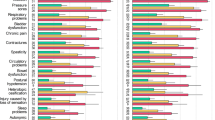Abstract
Past studies of the long term consequences of spinal cord injury (SCI) have used both univariate and multivariate techniques to identify variables predictive of long term problems. Studies using multiple regression and discriminant analysis, while generating valuable data, have often used insufficient sample sizes and have rarely included cross-validation procedures. In the present study, completed questionnaires were obtained from 347 persons with SCI in 1985, 154 of whom also completed questionnaires in 1974. Factor analysis was first used to identify 3 underlying dimensions of self-reported problems including Emotional Distress, Dependency, and Health Problems. Scores on these 3 dimensions were then used as dependent variables with multiple regression. Three organic variables (age, duration of injury and injury level) and 5 adjustment variables (work status, activity level, medical stability, interpersonal satisfaction and economic satisfaction) were used as predictors. Regression equations were generated on the subjects completing only the 1985 questionnaire (N = 193) and cross-validated on persons completing both questionnaires (n = 154). The highest cross-validated squared multiple correlations were obtained for Dependency (SMC = 0.43), followed by Health Problems (SMC = 0.28) and Emotional Distress (SMC = 0.15). Adjustment variables proved to be the better predictors than organic variables, even though the organic variables were entered first. Organic predictors were somewhat useful in predicting Health Problems and Dependency, but of no value in predicting Emotional Distress. When the 1974 data was used to predict 1985 problems considerably smaller SMCs were noted (Dependence = 0.19; Health Problems = 0.11; Emotional Distress = 0.07), although all SMC's remained significant (p < 0.01). Implications for counsellors and other rehabilitation professionals are discussed.
Similar content being viewed by others
Log in or create a free account to read this content
Gain free access to this article, as well as selected content from this journal and more on nature.com
or
References
Cogswell B 1968 Self socialization: readjustment of paraplegics into the community. Journal of ehabilitation 34: 11–13, 35.
Cook D W 1979 Psychological adjustment to spinal cord injury: incidence of denial, depression and anxiety. Rehabilitation Psychology 26: 97–104.
Crewe N M, Athelstan G T, Bower A S 1978 Employment After Spinal Cord Injury: A Handbook for Counselors. University of Minnesota, Department of Physical Medicine & Rehabilitation, Minneapolis.
Crewe N M, Athelstan G T, Krumberger J 1979 Spinal cord injury: a comparison of preinjury and postinjury marriages. Archives of Physical Medicine and Rehabilitation 60: 252–256.
DeJong G, Branch L G, Corcoran P J 1984 Independent living outcomes in spinal cord injury: multivariate analyses. Archives of Physical Medicine and Rehabilitation 65: 66–73.
DeVivo M J, Fine P R 1982 Employment status of spinal cord injured patients 3 years after injury. Archives of Physical Medicine and Rehabilitation 63: 200–203.
Dew M A, Lynch K A, Ernst J, et al. 1985 A causal analysis of factors affecting adjustment to spinal cord injury. Rehabilitation Psychology 30: 39–46.
Frank R G, Elliot T R 1987 Life stress and psychological adjustment following spinal cord injury. Archives of Physical Medicine and Rehabilitation 68: 344–347.
Geisler W O, Jousse A T, Wynne-Jones M, Breithaupt D 1983 Survival in traumatic spinal cord injury. Paraplegia 21: 364–373.
Goldberg R T, Freed M M 1982 Vocational development of spinal cord injury patients: an 8-year follow-up. Archives of Physical Medicine and Rehabilitation 63: 207–210.
Gordon W A, Harasymiw S, Bellile S, et al. 1982 The relationship between pressure sores and psychosocial adjustment in persons with spinal cord injury. Rehabilitation Psychology 27: 185–191.
Green B C, Pratt C C, Grigsby T E 1984 Self-concept among persons with long-term spinal cord injury. Archives of Physical Medicine and Rehabilitation 65: 751–754.
Kemp B J, Vash C L 1971 Productivity after injury in a sample of spinal cord injured persons: a pilot study. Journal of Chronic Diseases 24: 259–275.
MacDonald M R, Nielson W R, Cameron M G P 1987 Depression and activity patterns of spinal cord injured persons living in the community. Archives of Physical Medicine and Rehabilitation 68: 339–343.
Malec J, Neimeyer R . 1983 Psychologic prediction of duration of impatient spinal cord injury rehabilitation and performance of self-care. 1983 Archives of Physical Medicine and Rehabilitation 64: 359–363.
Nepomuceno C, Fine P R, Richard J S, et al. 1979 Pain patients with spinal cord injury. Archives of Physical Medicine and Rehabilitation 60: 605–609.
Nickerson E T 1971 Some correlates of adjustment by paraplegics. Perceptual and Motor Skills 32: 11–23.
Norris-Baker C, Stephens M A P, Rintala D H, et al., 1981 Patient behavior as a predictor of outcomes in spinal cord injury. Archives of Physical Medicine and Rehabilitation 62: 602–608.
O'Donnell J, Cooper J, Gessner J, et al. 1981-1982 Alcohol, drugs, and spinal cord injury. Alcohol Health and Research World 27–29.
Richards J S 1986 Psychologic adjustment to spinal cord injury during first postdischarge year. Archives of Physical Medicine and Rebhabilitation 67: 362–365.
Richards J S, Meredith R L, Nepomuceno C, et al. 1980 Psycho-social aspects of chronic pain in spinal cord injury. Pain 8: 355–366.
Rintala D H, Willems E P 1987 Behavioural and demographic predictors of postdischarge outcomes in spinal cord injury. Archives of Physical Medicine and Rehabilitation 68: 357–362.
Siller J 1969 Psychological situation of the disabled with spinal cord injury. Rehabilitation Literature 30: 290–296.
Siller J, Chipman A, Ferguson L, Vann D 1967 Attitudes of the nondisabled towards the physically disabled. Studies in reaction to disability XI. New York: School of Education, New York University.
Trieschmann R 1980 Spinal cord injuries: The psychological, social and vocational adjustment. Pergamon Press, Elmsford, New York.
Woodrich F, Patterson J B 1983 Variables related to acceptance of disability in persons with spinal cord injuries. Journal of Rehabilitation 49: 26–30.
Author information
Authors and Affiliations
Rights and permissions
About this article
Cite this article
Krause, J., Crewe, N. Long term prediction of self-reported problems following spinal cord injury. Spinal Cord 28, 186–202 (1990). https://doi.org/10.1038/sc.1990.24
Issue date:
DOI: https://doi.org/10.1038/sc.1990.24


